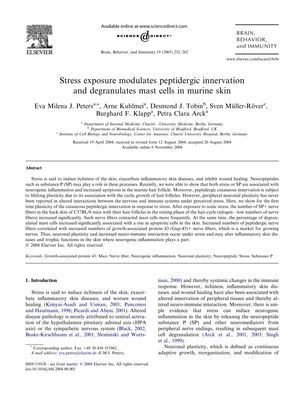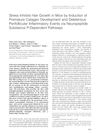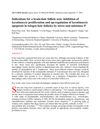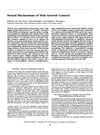Stress exposure modulates peptidergic innervation and degranulates mast cells in murine skin
May 2005
in “Brain Behavior and Immunity”

TLDR Stress increases nerve fibers and immune cell activity in mouse skin, possibly worsening skin conditions.
The 2005 study explored how stress affects the skin's nervous system and immune response in mice. It found that stress exposure significantly increased the number of substance P-positive (SP+) nerve fibers and growth-associated protein 43 (Gap-43)+ nerve fibers, indicating neuronal plasticity. These nerve fibers were more frequently in contact with mast cells, which were often degranulated, suggesting enhanced neuro-immune interactions. The study also observed an increase in apoptotic cells in the skin following stress. The results suggest that stress can lead to neurogenic inflammation and tissue damage, potentially exacerbating skin diseases. The study involved 5 mice per group, with statistical significance determined using the Mann-Whitney U test and p-values below 0.05.
View this study on sciencedirect.com →
Cited in this study

research Stress Inhibits Hair Growth in Mice by Induction of Premature Catagen Development and Deleterious Perifollicular Inflammatory Events via Neuropeptide Substance P-Dependent Pathways
Stress stops hair growth in mice by causing early hair growth phase end and harmful inflammation through a specific nerve-related pathway.
research Developmental timing of hair follicle and dorsal skin innervation in mice
Nerve growth in mouse skin and hair follicles happens in stages and is closely linked to hair development.

research Indications for a brain‐hair follicle axis: inhibition of keratinocyte proliferation and up‐regulation of keratinocyte apoptosis in telogen hair follicles by stress and substance P
Stress can cause hair loss by negatively affecting hair follicles and this effect might be reversed with specific treatments.

research Neural Mechanisms of Hair Growth Control
Nerves and chemicals in the body can affect hair growth and loss.